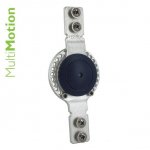Hi-
I make braces and artificial limbs for a living and I have no experience in CNC. I would like to make a smaller adjustable ankle or joint out of aluminum. Here is a picture of what I am trying to fabricate but I would like to make it smaller. It is esentially just to sticks with circles on the ends and they rotate about a center axis. One of them also has holes drilled around the border and a set screw on each end so that we can control the range they rotate about each other.

Range of Motion Joint - MultiMotion™ Contracture Management - Contracture Management & ROM Joints | Allard USA - Support For Better Life!
My question is. If I am able to mill out the two pieces how do I join them in the middle so that they can rotate about the center axis without getting bound up? I think if I used 1/8" alumniun it would likely be strong enough. I could use a chicago screw and washers to hold it togther but I think the joint wouldn't rotate smoothly. Are there parts that I can use for the center post available online?
Any help would be appreciated.
thx, j
I make braces and artificial limbs for a living and I have no experience in CNC. I would like to make a smaller adjustable ankle or joint out of aluminum. Here is a picture of what I am trying to fabricate but I would like to make it smaller. It is esentially just to sticks with circles on the ends and they rotate about a center axis. One of them also has holes drilled around the border and a set screw on each end so that we can control the range they rotate about each other.

Range of Motion Joint - MultiMotion™ Contracture Management - Contracture Management & ROM Joints | Allard USA - Support For Better Life!
My question is. If I am able to mill out the two pieces how do I join them in the middle so that they can rotate about the center axis without getting bound up? I think if I used 1/8" alumniun it would likely be strong enough. I could use a chicago screw and washers to hold it togther but I think the joint wouldn't rotate smoothly. Are there parts that I can use for the center post available online?
Any help would be appreciated.
thx, j


